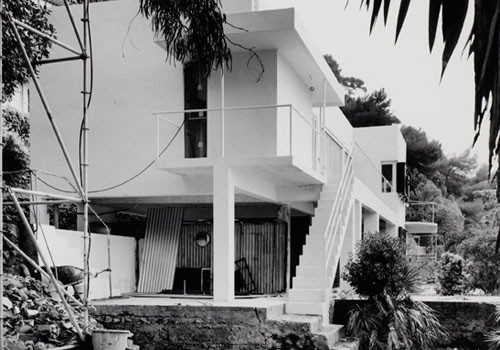Kasper Akhøj
23 Jul - 29 Aug 2010
KASPER AKHØJ
Welcome (TO THE TEKNIVAL)
July 23, 2010 - August 29, 2010
In his work, Kasper Akhøj addresses aspects of architecture and design history. In the exhibition “Welcome (TO THE TEKNIVAL)” at Künstlerhaus Stuttgart, he presents two new projects: one on the recent restoration of Eileen Gray’s modernist Villa E.1027 (1929) and the other on the display system Abstracta (Poul Cadovius, 1960). With photographs and sculpture, he follows the transformation of the original design in its application and usage over the course of time. The exhibition reflects on the object’s contingency on history as well as the relationship between design and appropriation.
In “Welcome (TO THE TEKNIVAL)”, an ongoing work since 2008, the authority of historiography is addressed. At the center of the project is the Villa E.1027 in Southern France, designed by modernist architect and furniture designer Eileen Gray, which is currently undergoing restoration. Based on the history of the building, which among other things contains a series of wall paintings by the famous architect Le Corbusier created against the will of the building’s architect, the decisions about what is considered worth keeping or what is original are debated. Akhøj regularly documents the progress of the site in order to record the historical layers of the building, which are simultaneously reconstructed and destroyed. The title of the work refers to two pieces of graffitti in the house that stand beside each other, yet originate from different time periods, one of them half erased by a layer of black paint.
The second work, “Abstracta”, ongoing since 2007, focuses on a display system that the Danish architect Poul Cadovius originally developed in 1960 for a World’s Fair. In 2006, Kasper Akhøj participated in a research project in former Yugoslavia when he noticed a modernist display system used in a variety of contexts, from shoe stores and market stands to museum exhibitions. Consequently, the artist embarked on a journey to trace the migratory movement of the modular display system from the West Balkan states back to its earlier incarnations in China, eventually leading to its origins in Denmark. Alongside photographic documentation of the system in application, Kasper Akhøj uses the various elements he has collected over the years as material for sculptural works. In its spatial presentation, the installation recalls the utopian architecture of Late Modernism, like modular megastructures, in a model perspective, and thus recollects a context out of which the display system originated.
Kasper Akhøj (*1976) lives in Copenhagen and New York. He is currently Artist in Residence at the 29th São Paulo Biennial and will have a solo exhibition at Wiels – Center for Contemporary Art, Brussels later this year.
The exhibition has been developed in cooperation with Overgaden, Copenhagen.
Welcome (TO THE TEKNIVAL)
July 23, 2010 - August 29, 2010
In his work, Kasper Akhøj addresses aspects of architecture and design history. In the exhibition “Welcome (TO THE TEKNIVAL)” at Künstlerhaus Stuttgart, he presents two new projects: one on the recent restoration of Eileen Gray’s modernist Villa E.1027 (1929) and the other on the display system Abstracta (Poul Cadovius, 1960). With photographs and sculpture, he follows the transformation of the original design in its application and usage over the course of time. The exhibition reflects on the object’s contingency on history as well as the relationship between design and appropriation.
In “Welcome (TO THE TEKNIVAL)”, an ongoing work since 2008, the authority of historiography is addressed. At the center of the project is the Villa E.1027 in Southern France, designed by modernist architect and furniture designer Eileen Gray, which is currently undergoing restoration. Based on the history of the building, which among other things contains a series of wall paintings by the famous architect Le Corbusier created against the will of the building’s architect, the decisions about what is considered worth keeping or what is original are debated. Akhøj regularly documents the progress of the site in order to record the historical layers of the building, which are simultaneously reconstructed and destroyed. The title of the work refers to two pieces of graffitti in the house that stand beside each other, yet originate from different time periods, one of them half erased by a layer of black paint.
The second work, “Abstracta”, ongoing since 2007, focuses on a display system that the Danish architect Poul Cadovius originally developed in 1960 for a World’s Fair. In 2006, Kasper Akhøj participated in a research project in former Yugoslavia when he noticed a modernist display system used in a variety of contexts, from shoe stores and market stands to museum exhibitions. Consequently, the artist embarked on a journey to trace the migratory movement of the modular display system from the West Balkan states back to its earlier incarnations in China, eventually leading to its origins in Denmark. Alongside photographic documentation of the system in application, Kasper Akhøj uses the various elements he has collected over the years as material for sculptural works. In its spatial presentation, the installation recalls the utopian architecture of Late Modernism, like modular megastructures, in a model perspective, and thus recollects a context out of which the display system originated.
Kasper Akhøj (*1976) lives in Copenhagen and New York. He is currently Artist in Residence at the 29th São Paulo Biennial and will have a solo exhibition at Wiels – Center for Contemporary Art, Brussels later this year.
The exhibition has been developed in cooperation with Overgaden, Copenhagen.

